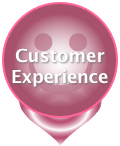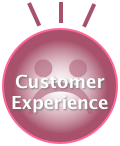 How to Boost the Power of Customer Journey Maps shows how firms can increase the accuracy and power of their journey maps by using digital social data in practical new ways that almost all customer experience pros overlook.
How to Boost the Power of Customer Journey Maps shows how firms can increase the accuracy and power of their journey maps by using digital social data in practical new ways that almost all customer experience pros overlook.
Would you willingly base multimillion dollar brand and product decisions on a hodgepodge of 20th century research methods?
That’s exactly what 99% of brands and agencies do, based on my just-completed review of customer experience, design, marketing, market research, and software firm posts. The good news is, you can improve the accuracy and power of your journey maps by using digital social data in a way that’s hidden in plain view.
Customer Journey Map Research Methods
 First, some results of my research on customer journey mapping research methods. The most common research methods mentioned in the context of customer journey maps were: social media (2,170), survey (1,470), interview (611), focus group (98), ethnography/field study (42), and sentiment analysis (17). Moreover, firms usually use social media as a touchpoint or for context of the brand, not for serious customer experience insights, so surveys were the top true research method.
First, some results of my research on customer journey mapping research methods. The most common research methods mentioned in the context of customer journey maps were: social media (2,170), survey (1,470), interview (611), focus group (98), ethnography/field study (42), and sentiment analysis (17). Moreover, firms usually use social media as a touchpoint or for context of the brand, not for serious customer experience insights, so surveys were the top true research method.
In addition, virtually all the customer journey map examples and processes I reviewed were brand-focused, not customer-focused. Although this is understandable because brands/agencies have better information about themselves than customers, it seriously weakens firms’ ability to empathize with and serve customers better.
Using Social Data to Boost the Power of Your Customer Journey Maps
 First, realize that customers and prospects are having detailed interactions about all stages of their journeys in social media. The first step is to rough out 2-4 personas that you deem as your business’s most valuable customers. Create searches that identify them discretely in digital public. Use your results from this persona study to iterate the personas. Their contextual demographics are less important than their situations in which you are relevant. For example, a middle-aged female dog owner is less relevant that a dog owner who’s developing Alzeimer’s. Using this approach, you refine your personas on quantifiable digital data that you can monitor from now on very easily.
First, realize that customers and prospects are having detailed interactions about all stages of their journeys in social media. The first step is to rough out 2-4 personas that you deem as your business’s most valuable customers. Create searches that identify them discretely in digital public. Use your results from this persona study to iterate the personas. Their contextual demographics are less important than their situations in which you are relevant. For example, a middle-aged female dog owner is less relevant that a dog owner who’s developing Alzeimer’s. Using this approach, you refine your personas on quantifiable digital data that you can monitor from now on very easily.
Follow a similar process for your journey stages. You can begin with the most basic model: before, during, and after using your product. Create searches to discretely identify each journey stage. Once you’ve validated the stages using digital quantifiable data, consider subsegmenting the journey stages, so you can tunnel into customers’ delights and frustrations. Keep in mind, when you’ve iterated these searches, you have a monitoring tool you can use from now on, so your journey map will be real-time.
For a more detailed description of the search iteration process, see the Digital Ecosystem Audit.
How to Move From Firm-Focused to Customer-Focused Customer Journey Maps
 Most journey maps unknowingly ground their maps in the usage of the product, which is not customer-focused. You can correct this by realizing that customers only buy products to “do jobs,” to create some meaningful outcome for themselves. So change your focus to customers’ outcomes and desired experiences, not their use of the product/service.
Most journey maps unknowingly ground their maps in the usage of the product, which is not customer-focused. You can correct this by realizing that customers only buy products to “do jobs,” to create some meaningful outcome for themselves. So change your focus to customers’ outcomes and desired experiences, not their use of the product/service.
There’s a huge difference in emphasis between customers’ willingness to buy products to fulfill their outcomes (customer focus) and purchase and use (firm focus).
Practically speaking, improve your map’s power by extending it on each side. I encourage clients to encompass, on the left side of the map, the situations in which customers begin realizing they have a problem or opportunity that will lead to their consideration of products/services. Before they even think about any product. This is a gold mine for product/service development teams, and for engaging them with experiential social media. On the right side, extend past their use of the product, through maintenance and disposal. Based on the outcomes they wanted, what other situations to they typically encounter? You can mine social data for all kinds of patterns and learn how to serve them much better.
Most exciting, since more firms concentrate their efforts around the product purchase, you can use your customer journey map to be much more empathic and relevant than your competitors. Being more empathic is the key to serving your customers better.
Other Exciting Things to Do
- Since your results from these data tools can be used to monitor each stage of the journey, you can use them to measure the impact of your customer experience initiatives—continuously.
- Create a dashboard powered by your searches to monitor each journey segment in real-time, and each persona. Create searches for customer outcomes, and monitor those, too.
- Virtually all customer journey map posts imply that, although “no two customer journeys are the same,” they only have one map. Once you develop and work with one, you can duplicate the process to create more granular journey maps, say, one for each high impact persona.

Leave a Reply
You must be logged in to post a comment.